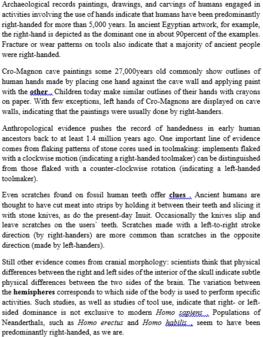Read the following passage and mark the letter A, B, C, or D on your answer sheet to indicate the correct answer to each of the questions from 35 to 42.
A survey is a study, generally in the form of an interview or a questionnaire, which provides information concerning how people think and act. In the United States, the best-known surveys are the Gallup poll and the Harris poll. As anyone who watches the news during presidential campaigns knows, these polls have become an important part of political life in the United States.
North Americans are familiar with the many "person on the street" interviews on local television news shows. While such interviews can be highly entertaining, they are not necessarily an accurate indication of public opinion. First, they reflect the opinions of only those people who appear at a certain location. Thus, such samples can be biased in favor of commuters, middle-class shoppers, or factory workers, depending on which area the news people select. Second, television interviews tend to attract outgoing people who are willing to appear on the air, while they frighten away others who may feel intimidated by a camera. A survey must be based on a precise, representative sampling if it is to genuinely reflect a broad range of the population.
In preparing to conduct a survey, sociologists must exercise great care in the wording of questions. An effective survey question must be simple and clear enough for people to understand it. It must also be specific enough so that there are no problems in interpreting the results. Even questions that are less structured must be carefully phrased in order to elicit the type of information desired. Surveys can be indispensable sources of information, but only if the sampling is done properly and the questions are worded accurately.
There are two main forms of surveys: the interview and the questionnaire. Each of these forms of survey research has its advantages. An interviewer can obtain a high response rate because people find it more difficult to turn down a personal request for an interview than to throw away a written questionnaire. In addition, an interviewer can go beyond written questions and probe for a subject's underlying feelings and reasons. However, questionnaires have the advantage of being cheaper and more consistent.
According to paragraph 3, the most important thing for an effective survey is ___.
A. a high number of respondents
B. carefully worded questions
C. an interviewer's ability to measure respondents' feeling
D. a sociologist who is able to interpret the results




Theo như đoạn 3, điều quan trong nhất cho một cuộc khảo sát hiệu quả là ______.
A. số lượng người phản hồi lớn
B. những câu hỏi được trau chuốt cẩn thận về câu từ
C. khả năng đo đạc được cảm xúc của những người được khảo sát
D. một nhà xã hội học người có khả năng diễn giải kết quả của cuộc khảo sát đó
Thông tin: An effective survey question must be simple and clear enough for people to understand it. It must also be specific enough so that there are no problems in interpreting the results.
Tạm dịch: Một câu hỏi khảo sát có hiệu quả phải đủ đơn giản, rõ ràng để mọi người có thể hiểu được. Nó phải đủ cụ thể để không có vấn đề gì trong việc diễn giải kết quả.
Chọn B